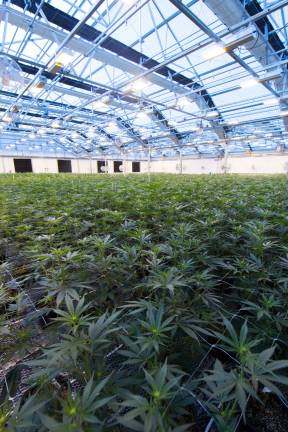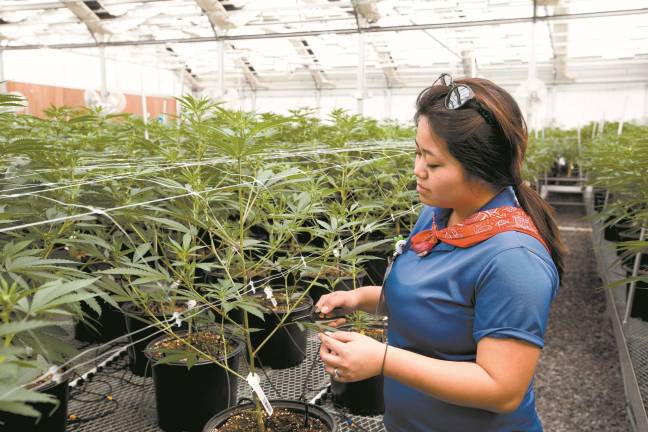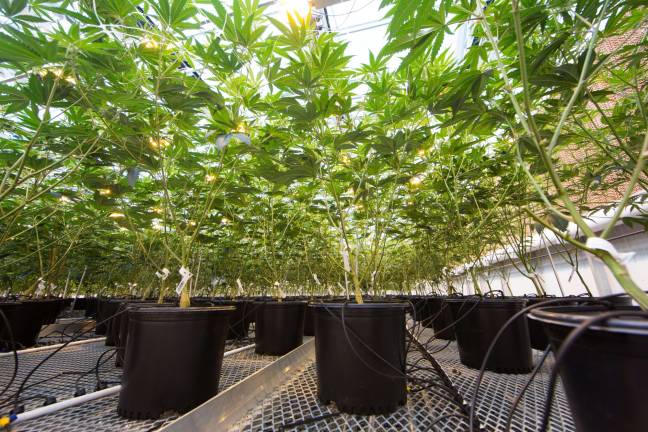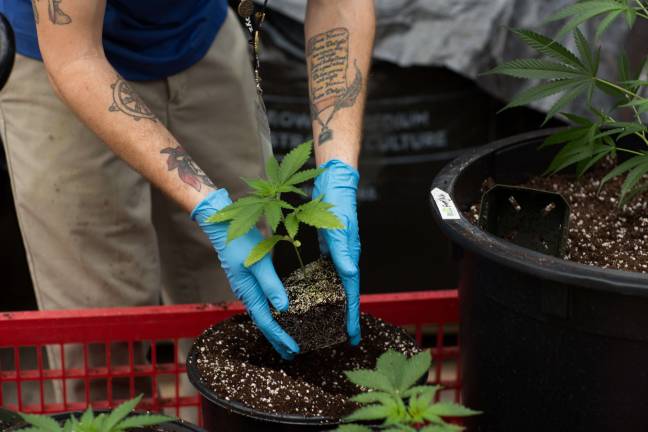All grown up





Inside New York’s most massive marijuana farm
By Becca Tucker
Photos by Michael Bloom
I meet Mike, my photographer, in the parking lot of a corporate park in rural Montgomery, NY. It’s been a couple years since we’ve worked together. We greet with a hug.
“You smell good,” I say. What I mean is, I know you’re good at your job but it’s not even 9 a.m. and you’ve already waked and baked?
No, no, he said. It’s coming from inside.
Two heavily tattooed security guards vet us in a foyer, checking driver’s licenses and punching in a code before the door opens into an institutional hallway. We hang a right into a cavernous room, whose white walls are bare except for some small windows way up high. The room’s perimeter is occupied by a smattering of cubicles and offices, but the middle is starkly empty. Room, as I will discover, to grow.
This $30 million facility, which includes two acres of greenhouses, constitutes the biggest marijuana grow in the state, and one of the biggest — and brand spanking newest — in the country. Given its monumental scale, plus the general secrecy that tends to shroud the growing of a highly coveted crop that, by the way, the feds still consider illegal, I didn’t hold out much hope that Pharmacann would return my email.
I was happily surprised, then, to hear back from Patrick McCarthy, who it turns out is not just a PR guy but a rather prominent lobbyist who was once former Governor Pataki’s top aide. Yes, they would be happy to give little Dirt a private tour.
I was surprised again, after we donned our white lab coats, to find that our entourage in the beginning of our three-hour tour included not one but six Pharmacann employees, each one of whom could be the subject of his or her own feature story, plus two security guards trailing us the entire time.
It was the most people I’d ever interviewed at once, I said.
“We’re a family,” said Colleen Hughes, who handles communications for Pharmacann.
They do seem to be a close-knit crew. From the lab tech to the guards, workplace satisfaction appears to be through the roof. But there’s more to the story. It turns out this operation, while it’s on the cutting edge of an industry that’s exploding nationwide, is actually desperate for attention.
The five companies that won the golden ticket – licenses to grow and sell marijuana in New York State – went out and invested a cumulative $50 million to start up, said McCarthy. A year and change later, they find themselves more or less ignored by the state and by skittish doctors, and hamstrung by a very short list of qualifying diseases and a prohibitively high cost to patients. Insurance doesn’t cover this, so patients have to pay the full cost of an initial consultation, then pony up between $100 and $400 a month for the marijuana.
As of late March, there were 911 doctors registered for the NYS Medical Marijuana Program, and a total of 15,000 patients – a relatively miniscule number.
“My colleagues don’t want to hear about it, they don’t want to know about it, they have such prejudgment on it that it’s really unfortunate for patients,” said Dr. Lynne Bennett of Albany, a family practitioner with 33 medical marijuana patients who suffer from chronic pain, seizures, Parkinson’s or cancer. “They’re worried about prescribing illicit drugs. I don’t see it that way.”
An evangelical Christian and political conservative, Bennett surprised her friends when she got certified as a marijuana doctor. “I’ve been treating chronic pain for so long with opioids,” she said. “I’ve seen what it’s doing to people. I’ve seen heroin destroy people and it usually starts with some opioid addiction. If I could get every one of my patients off opioids, I would be so ecstatic.”
Chronic pain was recently added to the list of qualifying diseases, and PTSD is under discussion. That may mean big changes are afoot, but in the meantime the five big winners in New York find themselves operating at a fraction of capacity and hemorrhaging money. Now, too, they are scratching their heads as the state looks to register five more companies to grow and distribute marijuana, a “reckless expansion” that risks putting them all out of business, said McCarthy.
An entire acre of greenhouse at Pharmacann sits unfinished, a testament to the gridlock that’s standing between it and the largest market in the country.
While they wait for patients, Pharmacann keeps making and freezing the oil that will be made into vape pens and tinctures, refining and re-refining their product.
What will happen when they fill the freezer?
“We’ll buy another freezer,” said Hughes.
There are two types of employees here at Pharmacann, I am told. There are the passionate plant guys, and the data-driven science guys.
The science guys are lab nerds who came up in Big Ag companies like Dupont and Big Pharma companies like Pfizer and Merck. They are epitomized by operations manager Louis Mejias, who has co-authored a patent for orally disintegrating tablets. He brings out a baggie of blue-and-white pills pressed onsite: time release capsules. These don’t contain any active ingredients, but this is what the future of marijuana could look like. Or patches, lotions, creams – anything Big Pharma can do, they can do here.
The plant guys, meanwhile, have jumped onboard from other states with existing legal marijuana industries, where they’ve seen ramen-eating roommates turn into mega-millionaires; and some have just recently come up, with disbelieving grins, from the underground.
Plant guys can be idenfitifed by comments like: “The opportunity to stick it to the man, is, like, really important to me.” So says Sean Caffrey, 37, the cultivation manager at Pharmacann. He wears Oakleys on his head, a five o’clock shadow and an impish smile. A saxophone player, Caffrey grew up on Long Island and majored in music in college. He followed the marijuana industry out to Colorado, where he opened a dispensary called the Kine Mine on a shoestring budget of $50,000. When New York adopted medical marijuana, he took it as an invitation to return to his home state. He settled in Warwick and starting at Pharmacann last May.
Caffrey is passionate about being part of the movement to “end prohibition.” He’s not just a plant guy, but “pure cannabis, exactly the person we want,” in the words of one colleague.
Today’s buttoned-up cannabis operation, surveilled by 400 cameras, looks like it has cut ties with its scruffy, tie-dyed past. The logo embroidered onto Pharmacann employees’ white lab coats is a pleasantly fat green droplet, a far cry from the iconic seven-fingered leaf ubiquitous out west. Once the product is on the dispensary shelf, state law requires familiar street names to be scrubbed and replaced with antiseptic “brand” names. Pharmacann labels its brands with colors from blue, the most potent, to yellow.
But the plant guys will tell you. They have not forgotten where their beloved Gupta Kush and Girl Scout Cookie came from. The remarkable size and potency of today’s strains cannot be ascribed to crossbreeding that went down in this shiny, futuristic facility, where you can water the entire crop with the click of a mouse, where the lights automatically dim when the sun comes out from behind a cloud, where good mites crawl out from their very expensive pouches to devour the bad mites.
The horticulturalists responsible for developing these strains didn’t have any of those bells or whistles. What they did have was time. They’ve been tinkering in basements and closets since the sixties. They may well have exchanged gardening tips in jail.
“Everything we grow is a hybrid that’s been bred underground for many many decades, black market style,” said Caffrey. Caffrey relates the example of a guy came back from serving in a private armed security force in Iraq, carrying seeds for a strain that Colorado growers began cultivating under the name Blackwater.
If we could know them, the stories behind today’s uber-potent cannabis strains, though edgier than the tale of Aunt Molly’s ground cherries or the Mortage Lifter tomato, would be just as all-American. But these vignettes won’t ever show up in a seed catalog. How these plants started growing here at all is not up for discussion, since it violates federal law to bring a seed into New York State.
Even the filter-less Caffrey won’t touch that question. “The seeds were here when I got here,” is all he’ll say.
These white walls are deliberately bare, nary a Bob Marley poster in sight. Pharmacann is positioning itself as the most above-board, grown-up, data-driven cannabis company there is, undaunted by the most stringent of markets, uber-high-tech but agile enough to go national at the drop of a hat, whenever that time comes. Vestiges of pot culture are not obvious, but they’re still around if you look close. Pink Floyd and reggae emanate from the quality assurance lab, coming from a laptop that’s also hooked up to a tower of analytical equipment worth $100,000. The tags around the stems of growing plants, along with bar codes, still bear their street names like “Tesla” and “Lovelace.” The holes in the ears of Todd Sutherland, 35, which are large enough to put a pencil through, hint at a countercultural past.
Do you take your earrings out for work? I asked.
Nah, he says, that’s from his old life.
Sutherland, from Walden, NY, is a jack of all trades who operates an extractor so large that, like the dinosaur at the Museum of Natural History, it occupies one entire room and part of another. The staff lovingly calls this intricate machine the BAE. The Big Ass Extractor turns about 1,200 pulverized plants into 400 kilos, or 880 pounds, of “goo” every two weeks.
Sutherland’s familiarity with plumbing, electrical wiring, and horticulture did not come from any sort of “classical” schooling, as he puts it. But the skills he honed on his own could not be a better fit for this job.
His new job title, extraction technician, “flows off the tongue real nice,” he said. “This is something I’ve had a lot of passion about. I wake up ready to hit the grid, man.”
Greg Halloran, 25, echoes that sentiment. “I’ve got a lot of friends that don’t like to go to work. I don’t have to deal with that,” he said. A history major from Minisink, Halloran also followed the marijuana industry out to Colorado. When Pharmacann opened up, his dad broke the news to Greg: you can move back home! Halloran is now an IPM (integrated pest management) specialist. He releases flying and crawling insects, from parasitic wasps to beneficial beetles, to hunt down the aphids and nearly microscopic red mites that gardeners know only too well, keeping pest pressures low without the use of chemicals. Talk about an interesting job.
Noni Goldman, 30, from Ithaca, wanted something more “mission-oriented” than her job at a caviar facility. Now she’s a generation specialist, which means she takes care of “the moms.” The moms are the four-to-five-month old stock plants that hold all of Pharmacann’s genetics, from which cuttings are taken. They look like small trees. Sometimes employees come and sit underneath them, absorbing their good energy. Goldman keeps track of how the cuttings from each mom do – based on yield, pest resistance, how easy they are to clone – so that they can decide which ones to keep. At this point they’ve narrowed their genetics down to 12 strains, with six moms of each strain.
“In this area, there used to be so few opportunities,” said Goldman. “Now there’s Amy’s Kitchen, Legoland, Pharmacann, all these businesses. People want to stay. Even people who live closer to the city want to move here.”
When it comes to mission, there’s a segment of Pharmacann employees – neither plant guys nor science guys – who spent their careers doing exactly the opposite of what they’re doing now. Those are the seven NYPD veterans who work security. In a way it’s not much different from being a policeman. “The rules are the rules, that’s why we’re here, to enforce the rules,” said Wayne Moran, 59, who lives in Rock Tavern, NY. “Whether you like it or not, that’s your job.”
But there is also a satisfying sense of coming full circle. “We arrested people for this, and now essentially we’re protecting it,” he said. “It feels pretty cool.”
Sidebar:
Medical marijuana docs near you
Madeleine Myers
Family practice
45 Quaker Ave.
Cornwall, NY
845-534-9590
Glen S. Kay
Family practice, Omni Medical Care
1418 Rte. 300
Newburgh, NY
845-566-6664
Paul Saladino
Internal medicine
407 Gidney Ave., Suite B
Newburgh, NY
845-561-7075
Daniel Perri
Pain management
60 Dunning Rd.
Middletown, NY
845-344-4477
Thomas R Eanelli
Radiation oncology, Horton Memorial Pavillon
75 Crystal Run Rd.
Middletown, NY
845-649-5566
Ralph J Alvarez
Internal medicine
9 Grand St.
Warwick, NY
845-986-6969